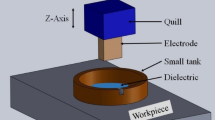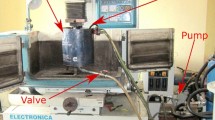Abstract
The quality and performance of products produced by the electrical discharge machining process mainly affected by the integrity of the machined surface. The recent development in the various assisted EDM process used magnetic field and mixed-phase dielectric fluids need to examine their effect on surface integrity. Therefore, in the present study, an investigation has been performed to evaluate the effect of a magnetic field and different dielectric conditions mainly liquid, liquid–air and liquid–argon gas mixture on surface integrity in the machining of AISI 304 steel. Their effect on surface and sub-surface features such as surface roughness, micro-cracks, recast layer thickness, heat affected zone, chemical and phase transformation have been compared. In addition, the effect of variation in the pressure of air/argon gas in the mixed phased dielectric and magnetic flux density on surface integrity have also been evaluated. The reactive nature of oxygen from air and inertness of argon gas mixed in liquid dielectric governed the heat supply and heat transfer rate into the discharge crater. The results showed that the assistance of air and argon gas narrow down the surface cracks by 55% and 72%, respectively, as compare to liquid dielectric. The magnetic field reduced the surface roughness by 18% and 32% in the air-assisted EDM and argon gas-assisted EDM, respectively. However, the combined assistance of magnetic field and air/gas increased the thickness of recast layer and HAZ as compared to EDM using liquid dielectric and without assistance of magnetic field.

















Similar content being viewed by others
Abbreviations
- AEDM:
-
Air-assisted electrical discharge machining
- EDM:
-
Electrical discharge machining
- EDX:
-
Energy dispersive X-ray
- GEDM:
-
Argon gas-assisted electrical discharge machining
- HAZ:
-
Heat affected zone
- MAEDM:
-
Magnetic field and air-assisted electrical discharge machining
- MGEDM:
-
Magnetic field and argon gas-assisted electrical discharge machining
- MRR:
-
Material removal rate
- REDM:
-
Rotary electrical discharge machining
- SEM:
-
Scanning electron microscope
- XRD:
-
X-ray diffraction
References
Shankar P, Jain VK, Sundararajan T (1997) Analysis of spark profiles during EDM process. Mach Sci Technol 1:195–217. https://doi.org/10.1080/10940349708945647
Pandey PC, Jilani ST (1986) Plasma channel growth and the resolidified layer in EDM. Precis Eng 8:104–110
Ekmekci B (2007) Residual stresses and white layer in electric discharge machining ( EDM ). Sci Appl Surf Eng Mech 253:9234–9240. https://doi.org/10.1016/j.apsusc.2007.05.078
Jianxin D, Taichiu L (2000) Surface integrity in electro-discharge machining, ultrasonic machining, and diamond saw c1tting of ceramic composites. Ceram Int 26:825–830
Lee HT (2004) Relationship between electrode size and surface cracking in the EDM machining process. J Mater Sci 39:6981–6986
Ramasawmy H, Blunt L, Rajurkar KP (2005) Investigation of the relationship between the white layer thickness and 3D surface texture parameters in the die sinking EDM process. Precis Eng 29:479–490. https://doi.org/10.1016/j.precisioneng.2005.02.001
Sidhom H, Ghanem F, Amadou T et al (2013) Effect of electro discharge machining (EDM) on the AISI316L SS white layer microstructure and corrosion resistance. Int J Adv Manuf Technol 65:141–153. https://doi.org/10.1007/s00170-012-4156-6
Khosrozadeh B, Shabgard M (2017) Effects of hybrid electrical discharge machining processes on surface integrity and residual stresses of Ti–6Al–4V titanium alloy. Int J Adv Manuf Technol 93:1999–2011. https://doi.org/10.1007/s00170-017-0601-x
Zhang Y, Liu Y, Ji R, Cai B (2011) Study of the recast layer of a surface machined by sinking electrical discharge machining using water-in-oil emulsion as dielectric. Appl Surf Sci 257:5989–5997. https://doi.org/10.1016/j.apsusc.2011.01.083
Govindan P, Joshi SS (2012) Analysis of micro-cracks on machined surfaces in dry electrical discharge machining. J Manuf Process 14:277–288. https://doi.org/10.1016/j.jmapro.2012.05.003
Shen Y, Liu Y, Dong H et al (2016) Surface integrity of Inconel 718 in high-speed electrical discharge machining milling using air dielectric. Int J Adv Manuf Technol. https://doi.org/10.1007/s00170-016-9332-7
Tao J, Shih AJ, Ni J (2008) Experimental study of the dry and near-dry electrical discharge milling processes. J Manuf Sci Eng 130(011002–1):011002–011009. https://doi.org/10.1115/1.2784276
Lin YC, Lee HS (2008) Machining characteristics of magnetic force-assisted EDM. Int J Mach Tools Manuf 48:1179–1186. https://doi.org/10.1016/j.ijmachtools.2008.04.004
Teimouri R, Baseri H (2012) Effects of magnetic field and rotary tool on EDM performance. J Manuf Process 14:316–322. https://doi.org/10.1016/j.jmapro.2012.04.002
Singh Bains P, Sidhu SS, Payal HS (2018) Investigation of magnetic field-assisted EDM of composites. Mater Manuf Process 33:670–675. https://doi.org/10.1080/10426914.2017.1364857
Joshi S, Govindan P, Malshe A, Rajurkar K (2011) Experimental characterization of dry EDM performed in a pulsating magnetic field. CIRP Ann - Manuf Technol 60:239–242. https://doi.org/10.1016/j.cirp.2011.03.114
Zhang Y, Zhang Z, Zhang G, Wenyuan L (2020) Reduction of energy consumption and thermal deformation in WEDM by magnetic field assisted technology. Int J Precis Eng Manuf Technol 7:391–404. https://doi.org/10.1007/s40684-019-00086-5
Liqing L, Yingjie S (2013) Study of dry EDM with oxygen-mixed and cryogenic cooling approaches. Procedia CIRP 6:344–350. https://doi.org/10.1016/j.procir.2013.03.055
Sen S, Ghosh A (1962) Variation of Townsend’s second coefficient in an electrodeless discharge in crossed electric and magnetic field. ProcPhys Soc 79:293–298
Heinz K, Kapoor SG, DeVor RE, Surla V (2011) An investigation of magnetic field assisted material removal in micro-EDM for nonmagnetic materials. J Manuf Sci Eng 133(021002):1–9. https://doi.org/10.1115/1.4003488
Beravala H, Pandey PM (2018) Experimental investigations to evaluate the effect of magnetic field on the performance of air and argon gas assisted EDM processes. J Manuf Process 34:356–373. https://doi.org/https://doi.org/10.1016/j.jmapro.2018.06.026
Patel KM, Pandey PM, Venkateswara Rao P (2009) Surface integrity and material removal mechanisms associated with the EDM of Al2O3 ceramic composite. Int J Refract Met Hard Mater 27:892–899. https://doi.org/10.1016/j.ijrmhm.2009.05.003
Singh NK, Pandey PM, Singh KK (2016) Experimental investigations into the performance of EDM using argon gas-assisted perforated electrodes. 6914. https://doi.org/https://doi.org/10.1080/10426914.2016.1221079
Lim LC, Lee LC, Wong YS, Lu HH (1991) Solidification microstructure of electrodischarge machined surfaces of tool steels. Mater Sci Technol 7:239–248
Bauer B, Remenar M (2011) Welding engineering and technology. Eolss
Smolkin MR, Smolkin RD (2006) Calculation and analysis of the magnetic force acting on a particle in the magnetic field of separator. analysis of the equations used in the magnetic methods of separation. IEEE Trans Magn 42:3682–3693. https://doi.org/10.1109/TMAG.2006.880688
Zhang C (2016) Study of small cracks on nanocomposite ceramics cut by WEDM. Int J Adv Manuf Technol 83:187–192. https://doi.org/10.1007/s00170-015-7569-1
Cusanelli G, Hessler-wyser A, Bobard F, Demellayer R (2004) Microstructure at submicron scale of the white layer produced by EDM technique. J Mater Process Tech 149:289–295. https://doi.org/10.1016/j.jmatprotec.2003.11.047
Lippold JC, Kotecki DJ (2005) Welding metallurgy and weldability of stainless steel. Wiley
Wang F, Liu Y, Zhang Y et al (2014) Compound machining of titanium alloy by super high speed EDM milling and arc machining. J Mater Process Tech 214:531–538. https://doi.org/10.1016/j.jmatprotec.2013.10.015
Davim JP (2013) Nontraditional machining processes. Springer, London
Beravala H, Pandey PM (2020) Characterization of debris formed in magnetic field-assisted EDM using two-phase dielectric fluid. J Adv Manuf Syst 19:629–640. https://doi.org/10.1142/S0219686720500353
Gholipoor A, Baseri H, Shakeri M (2016) Investigation of the effects of magnetic field on near-dry electrical discharge machining performance. Proc IMechE Part B J Eng Manuf Eng Manuf 230:744–751. https://doi.org/10.1177/0954405414558737
Acknowledgements
This work was supported by the Council of Scientific and Industrial Research (India) [Grant Numbers 22(0773)/18/EMR-II, 2018].
Author information
Authors and Affiliations
Corresponding author
Additional information
Technical Editor: Adriano Fagali de Souza.
Publisher's Note
Springer Nature remains neutral with regard to jurisdictional claims in published maps and institutional affiliations.
Rights and permissions
About this article
Cite this article
Beravala, H., Pandey, P.M. Experimental investigations to evaluate the surface integrity in the magnetic field and air/gas-assisted EDM. J Braz. Soc. Mech. Sci. Eng. 43, 213 (2021). https://doi.org/10.1007/s40430-021-02929-2
Received:
Accepted:
Published:
DOI: https://doi.org/10.1007/s40430-021-02929-2




